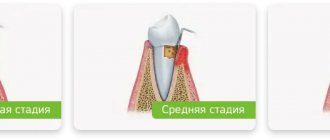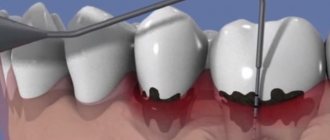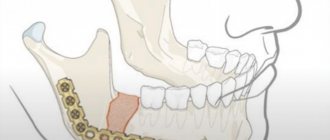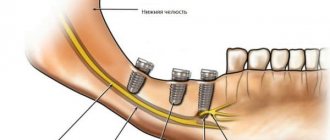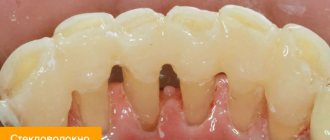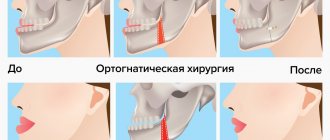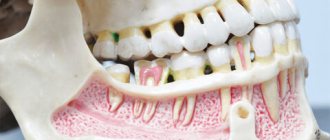From this article you will learn:
- what is curettage of gums and teeth (video),
- methods of its implementation, reviews,
- What is flap surgery for periodontitis?
The article was written by a practicing periodontist surgeon.
Curettage is a surgical technique for the treatment of chronic periodontitis, which involves scraping out the contents of periodontal pockets. Its goal is to remove granulations, subgingival dental deposits, the epithelial lining of the pockets, as well as a layer of necrotic “cement” on the surface of the tooth root from the pockets. This is a fairly complex intervention that requires surgical skills and should ideally be performed only by a periodontal surgeon (oral surgeon).
There are 2 methods of this operation in dentistry. Closed curettage is a technique that is preferred for shallow periodontal pockets up to 4.0 mm (which corresponds to mild periodontitis). Open curettage is a more complex surgical technique, which is indicated in the presence of periodontal pockets with a depth of more than 4.0 mm, i.e. carried out for moderate to severe periodontitis. The open technique requires good surgical skills, because... During the operation, the gums will peel away from the bone tissue around the teeth.
Closed curettage technique –
There is also an even more radical option for open curettage, which is called the term “flap operation” (we will also talk about this in more detail below). The following is a very important point. If the closed curettage technique has the right to be performed by ordinary dental therapists with advanced training in periodontics, then open curettage and flap operations can only be performed by dental surgeons or maxillofacial surgeons.
What is curettage
Normally, between the gum and the cervical area of each tooth there is a dentogingival junction that protects the tissues from the spread of pathological processes, microorganisms, and food particles. In the absence of adequate treatment for gum inflammation, destructive processes and local disruption of microcirculation lead to the destruction of the dentogingival junction, a periodontal pocket is formed - the space between the tooth root and the connective tissue of the gums, where a favorable environment is created for the active activity of pathogenic bacteria.
Thus, gingivitis, which most often manifests itself as bleeding and swelling of the gums, develops into a more serious dental pathology - periodontitis, the treatment of which is no longer possible without surgical interventions. The causes of the occurrence and spread of the inflammatory process may be poor hygiene, constant trauma to the teeth, and some somatic diseases.
Curettage is a procedure for cleaning the cavity between the gum and tooth root. Only after treating the root part of the tooth with careful removal of all pathological contents (granulations, plaque, stone), it is possible to create conditions for successful healing of the lesion and restore the dentogingival junction. Curettage of the periodontal pocket is the basis of periodontitis therapy, which is confirmed by positive reviews from doctors about the procedure. The method of curettage is selected by a specialist depending on the severity of periodontitis, the main criterion of which is the depth of the periodontal pocket.
Content:
Around each tooth there is a small gingival fold, tightly adjacent to its cervical part, which is called a physiological periodontal (gum) pocket.
With poor dental care or due to hereditary factors, soft plaque accumulates on the teeth, which, under the influence of microflora, turns into hard dental deposits - stones.
Tartar, accumulating on the tooth wall, pushes back the gingival fold, forming a pathological gingival pocket, which causes gum inflammation and bleeding. As a result of inflammation, bone tissue is destroyed, gums swell, bad breath appears, ligaments around the teeth are destroyed, teeth lose support, begin to loosen and eventually fall out.
Closed curettage of periodontal pocket
Closed curettage is a treatment technique performed in cases of mild or moderate pathology. Its peculiarity is that pockets are cleaned without incisions or gum detachment. After diagnosis, during which dental X-rays are necessarily studied and the depth of each pathological pocket is measured using periodontal instruments, local anesthesia is performed. The patient rinses the oral cavity with an antiseptic solution, and after complete anesthesia of the gums in the corresponding area, the doctor sequentially cleans each side of the tooth. Closed curettage of periodontal pockets is performed using a set of special hand instruments - scalers, curettes. The specialist inserts the instrument to the depth of the pocket and, using lever-like scraping movements, cleans the surface of the root and gums, as well as the bottom of the formation. Thus, the following are removed from the pathological pocket:
- hard subgingival calculus;
- granulations that have grown in the pocket;
- soft coating.
After basic cleaning with a periodontal bur, the accessible part of the tooth root is polished to prevent the accumulation of plaque on it and improve the conditions for restoring the periodontal attachment. The cleaned area is washed with an antiseptic. In one session, closed curettage can be performed in the area of 5-6 teeth.
Flaws
Gum curettage is a simple dental operation with good results. However, it is not without its drawbacks:
- Traumaticity. Like any surgical intervention, curettage injures soft tissue.
- The need for anesthesia. Normally, the operation is performed under local anesthesia. Sedation or general anesthesia is used in extreme cases or when the patient is in panic.
- Rehabilitation. The gums heal quickly, but at this time it is necessary to follow the recommendations and take care of the oral cavity. Infection of the wound can lead to complications.
Open curettage
The open curettage technique is more complex and requires making incisions in the gums. Thanks to gum detachment, deeper access is provided, and the doctor performs manipulations in the periodontal pocket with a wide view of the entire pathological focus. This allows the use of the open method in the treatment of moderate periodontitis, when the depth of the pathological pocket can reach 5 mm.
The operation is carried out as follows:
- After rinsing the mouth with an antiseptic and anesthesia, the dentist makes an incision at the tops of the gum papillae and peels away the tissue to expose the tooth roots for the duration of the procedure.
- With periodontal instruments, all surfaces are cleaned of necrotic tissue and plaque, vascular and epithelial formations are scraped out, and the bottom of the pocket is processed.
- Root polishing is carried out.
- The surgical field is washed with antiseptics, the gums are returned to their original position, and sutures are applied. If necessary, hemostatic sponges are used.
- The operation is completed by applying a bandage with therapeutic components to the treated area, designed to protect against oral fluid and injury.
During normal healing, the sutures are removed on average after 10 days. A course of local and general treatment with medications is prescribed. The patient takes a selected antibiotic and anti-inflammatory drugs. At home, baths and rinses are performed, and dental ointments are used. After thorough cleansing of pathological formations, drug therapy helps reduce signs of inflammation, eliminate pathogenic microflora, and promote tissue regeneration.
Indications
Prescribing curettage is possible only after a specialist has carried out diagnostic studies, including fluoroscopy. Based on the results obtained, the doctor will determine the required volume of intervention, choose the method of curettage, and draw up a treatment plan. Common indications for the procedure:
- inflammatory processes;
- abundant hard deposits leading to displacement of natural tissues;
- detected deep periodontal pockets;
- unstable dentition.
Laser curettage
Dental pockets can be cleaned using a laser device. Instead of curettes and scalers, manipulations in the periodontal pocket are carried out using a diode or erbium laser beam. The procedure is prescribed for mild periodontitis. Using a dental laser attachment, the doctor inserts a beam into the space between the gum and the surface of the tooth root. When a laser acts on pathological growths (granulation tissue), they coagulate - destruction under the influence of high temperature and evaporation. An important feature of the technique is the absence of bleeding during curettage of periodontal pockets with a laser, which is due to the instant cauterizing effect of the beam.
To better eliminate pathogenic flora, the laser method is combined with photodynamic therapy. To do this, before the procedure, the gums and pocket area are treated with a preparation based on chlorophyll, a plant pigment. Its molecules accumulate in periodontal cells affected by microorganisms and form photosensitizer compounds. Half an hour after applying the pigment, the doctor acts on the colored tissue with a visible spectrum laser, which activates the resulting photosensitizers. The compounds destroy bacterial cells and elements affected by them, actively releasing oxygen. Since the chlorophyll in the drug has a selective effect, the laser does not affect healthy tissue. According to patient reviews, the procedure is almost painless; a tingling sensation may be felt.
Advantages of the laser method:
- low risk of gum injury;
- fast healing;
- no bleeding.
Laser cleaning is the method of choice for a group of patients who have contraindications to standard curettage methods - patients with diabetes mellitus, serious cardiovascular diseases, and bleeding disorders.
WHO PERFORMS SUCH PROCEDURES?
Such procedures can be performed by a dental surgeon or surgeon. If the dentist does not have an education in the field of surgery (dental), then he cannot perform any of the above operations.
Such manipulations can be carried out using mechanical instruments or ultrasound. Most dental clinics today use ultrasound. In this case, the procedure will give a greater percentage of effectiveness, moreover, quickly and without pain.
In order to be sure that the disease will not return during treatment, the tooth root must be polished. This way the tooth enamel becomes smoother and tartar will not build up. And then the doctor will prescribe medications that will disinfect the oral cavity, and the gums will be able to reject any bacteria.
Deep curettage
Severe periodontitis is a serious pathology, accompanied by the presence of periodontal pockets deeper than 5 mm, in which bone pockets often appear. With such signs, more extensive interventions are indicated to cleanse subgingival deposits, especially if the lesion has spread to a large number of teeth. The large depth of the gaps between the gums and the tooth root requires visual control to completely remove the pathological contents, so a radical operation is performed with peeling off a flap of tissue in the area of half or the entire jaw to the depth of the lesion.
After exposing the roots, they undergo deep treatment: removal of epithelial growths, any deposits, affected cement, as well as altered bone tissue. The treated area is washed with antiseptics and stitches are applied. In the presence of severe bone loss, osteoplastic materials are used to promote regeneration. Healing of oral tissue continues for a month.
Causes of periodontitis and its consequences
Many people are too negligent about oral hygiene. This leads to the fact that plaque and hard deposits begin to form on the teeth, indicating the appearance of the first signs of periodontitis. These processes are accompanied by bleeding and inflammation of the gums. The primary signs of the development of periodontitis also include tooth mobility and the appearance of purulent discharge from under the gums.
Subsequently, the soft plaque on the teeth mineralizes and becomes tartar, which promotes the release of toxins. These, in turn, cause gum inflammation and other adverse consequences.
Such consequences, first of all, include the gradual resorption of bone tissue around the tooth. In its place, granulation tissue appears, which contains many microbes that absorb the bone. This process contributes to a significant acceleration of bone tissue atrophy.
Another unpleasant consequence is the formation of periodontal pockets. They represent an area with destroyed bone tissue and a cavity that is filled with granular tissue, pus and dental plaque. To detect this pathology, x-rays or probing are required. It is worth adding that the periodontal pocket is often called the dental or gingival pocket.
Identification of a deep periodontal pocket (from 3 mm) means that the patient will no longer be helped by drug therapy. This is due to the fact that the destruction process has already taken an irreversible form.
The ineffectiveness of drug and therapeutic treatments can be explained by several reasons:
- Even the most qualified doctor cannot guarantee the removal of all subgingival deposits by inserting an ultrasonic tip under the gum. The lack of confidence in the 100% result of therapy is due to the fact that no specialist will be able to control what is happening in the periodontal pockets. That is why a large amount of destructive sediment remains there.
- This procedure is considered quite labor-intensive and expensive. However, it does not guarantee complete elimination of the problem.
- If the specialist manages to completely remove all subgingival deposits from the pocket, favorable conditions for the development of periodontitis will still remain in the oral cavity. Therefore, even removing all deposits will not stop the progression of the infection.
In such situations, the only effective treatment option is surgery. Only in this case will the removal of all subgingival deposits, granulation tissue and periodontal pockets be ensured.
Surgical methods for treating periodontitis
There are 3 main methods of surgical treatment of this disease:
- open curettage;
- closed curettage;
- flap surgery.
Vacuum curettage
Vacuum curettage is a combined method; its technique is similar to the closed method of curettage of periodontal pockets, but together with standard curettes, hollow nozzles connected to a vacuum apparatus are used. Using a compressor, a vacuum is created in the device’s container, capable of sucking out mucus, deposits, and granulations from the space between the root and the gum. To improve visual control, the vacuum method can be performed in conjunction with gingivotomy (dissection of the gums).
Stages of the vacuum method:
- injection pain relief;
- scraping out accessible deposits from the tooth root with curettes;
- scraping granulations from the gums;
- bottom treatment with a vacuum nozzle;
- washing the cleaned area with antiseptics;
- applying a protective bandage for two days.
The vacuum method can be used in the area of 2-4 teeth in one session. As a result of the procedure, congestion is reduced, lymph and blood circulation is normalized. During the action of vacuum, microhematomas are formed, which help accelerate regeneration processes and, as a result, more rapid restoration of the periodontal junction.
POSITIVE AND NEGATIVE ASPECTS OF CURETAGE
One of the main positive aspects of curettage is the relatively low cost of the procedure: for one cleaning of a closed pocket they will charge 200 rubles, and for an open method - 2,000 rubles. In addition, it is possible to completely restore bone tissue, and in this case, an osteopreparative plays a significant role.
Gum pockets are also completely removed and all microorganisms that can cause pain are removed. After curettage, the teeth sit much more tightly in their sockets, therefore the percentage of tooth mobility decreases.
Flaws:
- low percentage of effectiveness in periodontal disease;
- sometimes an expensive method;
- The open operation takes too long; it can take at least 2 hours to treat seven teeth;
- the specialist who will carry out all the procedures must have a high category and be a pro in this field;
- If a person sees an inexperienced doctor, he can expect damage to the mucous membrane and minor wounds.
Indications and contraindications for surgery
Curettage is indicated for:
- mild (closed method) and moderate periodontitis (open method);
- some forms of gingivitis, accompanied by abundant subgingival deposits;
- absence of bone pockets.
Since curettage is a type of surgical intervention, it has a number of restrictions on its use in patients with severe systemic diseases, as well as under some unfavorable conditions that prevent operations in the oral cavity.
Contraindications related to the condition of local tissues include:
- discharge of pus from the gums;
- severe gum atrophy, thinning or changes in the walls;
- high tooth mobility;
- infectious lesion of the mucous membrane.
Contraindications related to general condition:
- bleeding disorders, diabetes mellitus (laser technology is recommended instead of standard technology);
- diseases of the cardiovascular system in the stage of decompensation;
- mental illnesses in which the patient is not able to adequately perceive the doctor’s manipulations during the procedure;
- feverish condition.
When visiting dentistry, before the procedure, diagnostic measures are required to select the optimal therapy and exclude contraindications to this treatment. Before carrying out a specific method of curettage of a periodontal pocket, a specialist will explain in detail what kind of cleaning method this is and give professional recommendations for the postoperative period.
Curettage of gums in Krasnodar
In Krasnodar, you can undergo the gum curettage procedure at our Symmetry dental clinic. Our specialists have extensive experience and high qualifications, confirmed by many specialized diplomas and positive reviews from our patients. We have all the necessary modern, high-quality dental equipment.
Dental care after curettage
The duration of recovery and the nature of recommendations during the recovery period depend on the chosen method of intervention.
The healing process when using the closed curettage technique for periodontal pockets takes about a week. Immediately after the operation, the pockets are filled with a blood clot, the presence of which is very important for normal tissue repair, so rinsing it out is prohibited. Brushing your teeth is not recommended for 2-3 days; a brush with soft bristles is used throughout the entire treatment period. Hot, irritating and solid foods should be avoided. At home, oral baths are made with solutions of antiseptics and anti-inflammatory drugs.
Immediately after open curettage, an ice pack is applied to the treated gum area. Drinking is allowed after 2-3 hours; to maintain the integrity of the protective bandage, it is recommended to use a straw. You will have to wait 6-8 hours to eat. In the first 2-3 weeks, increased sensitivity to temperature stimuli may occur. Brushing your teeth should be done with brushes with super-soft bristles, eating soft foods and taking baths with medications selected by your doctor. If you have a bad habit, smoking is prohibited for 8-9 weeks; during this period, physical activity and visiting a bathhouse or sauna are also not recommended.
Performing any curettage method requires the dentist to have excellent manual skills, attentiveness and careful attitude towards the gum tissue. At the Academy Dent clinic in Moscow, the procedure is performed by a specialist with many years of clinical experience in periodontology. Comprehensive equipment with advanced equipment allows the use of only modern operating techniques, and an individual approach at each stage of therapy and diagnosis makes treatment comfortable and painless for the patient.
Possible complications
Complications can be caused by the individual characteristics of the body or violation of the doctor’s requirements. Increased tooth sensitivity can last up to two months. In order to speed up its regression, you will need to use special pastes and gels prescribed by your doctor. Swelling and hematoma at the surgical site may persist for up to 14 days. This is not dangerous and goes away on its own. In some cases, tightness and difficulty opening the mouth may occur, but this problem usually disappears within a few days. Teeth can remain mobile for up to 3 weeks. You must wait until the end of this period before returning to solid foods.

